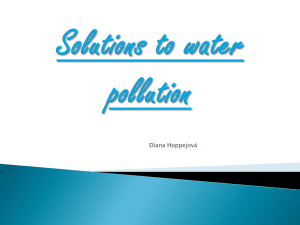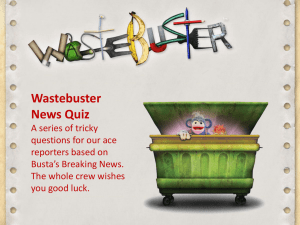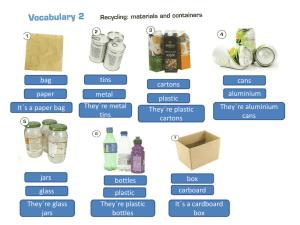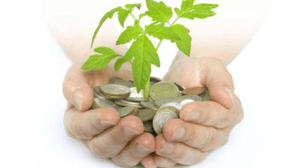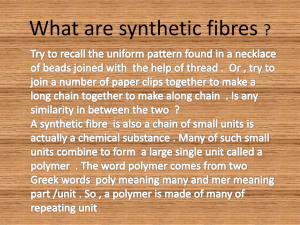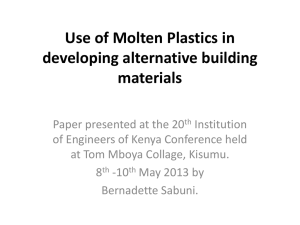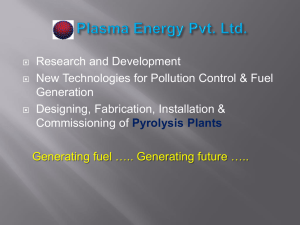Avoid These Plastics
advertisement
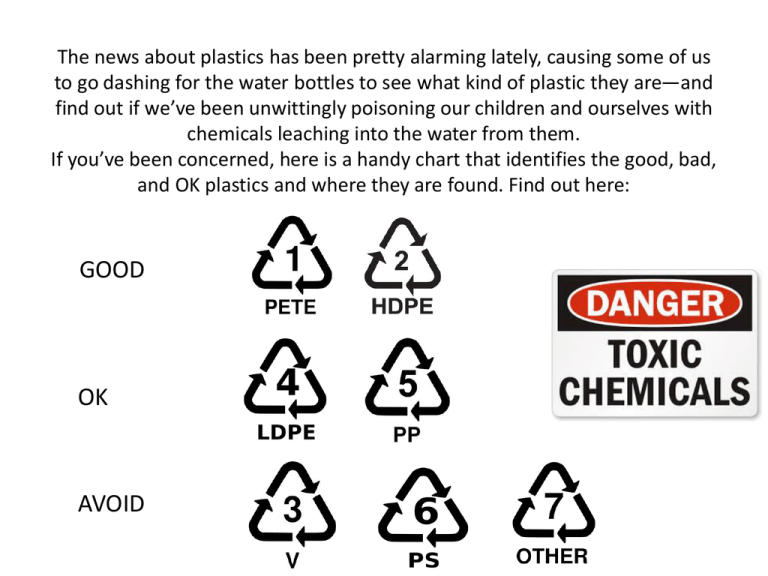
The news about plastics has been pretty alarming lately, causing some of us to go dashing for the water bottles to see what kind of plastic they are—and find out if we’ve been unwittingly poisoning our children and ourselves with chemicals leaching into the water from them. If you’ve been concerned, here is a handy chart that identifies the good, bad, and OK plastics and where they are found. Find out here: GOOD OK AVOID • #1 Polyethylene terephthalate (PET or PETE) Used to make soft drink, water, sports drink, ketchup, and salad dressing bottles, and peanut butter, pickle, jelly and jam jars. GOOD: Not known to leach any chemicals that are suspected of causing cancer or disrupting hormones. • #2 High density polyethylene (HDPE) Milk, water, and juice bottles, yogurt and margarine tubs, cereal box liners, and grocery, trash, and retail bags. GOOD: Not known to leach any chemicals that are suspected of causing cancer or disrupting hormones. • #3 Polyvinyl chloride (V or PVC) Most cling-wrapped meats, cheeses, and other foods sold in delicatessens and groceries are wrapped in PVC. BAD: To soften into its flexible form, manufacturers add “plasticizers” during production. Traces of these chemicals can leach out of PVC when in contact with foods. According to the National Institutes of Health, di2-ethylhexyl phthalate (DEHP), commonly found in PVC, is a suspected human carcinogen. • #4 Low-density polyethylene (LDPE) Some bread and frozen food bags and squeezable bottles. OK: Not known to leach any chemicals that are suspected of causing cancer or disrupting hormones, but not as widely recycled as #1 or #2. • #5 Polypropylene (PP) Some ketchup bottles and yogurt and margarine tubs. OK: Hazardous during production, but not known to leach any chemicals that are suspected of causing cancer or disrupting hormones. Not as widely recycled as #1 and #2. • #6 Polystyrene (PS) Foam insulation and also for hard applications (e.g. cups, some toys) BAD: Benzene (material used in production) is a known human carcinogen. Butadiene and styrene (the basic building block of the plastic) are suspected carcinogens. Energy intensive and poor recycling. • #7 Other (usually polycarbonate) Baby bottles, microwave ovenware, eating utensils, plastic coating for metal cans BAD: Made with biphenyl-A, a chemical invented in the 1930s in search for synthetic estrogens. A hormone disruptor. Simulates the action of estrogen when tested in human breast cancer studies. Can leach into food as product ages. Read more: http://www.care2.com/greenliving/which-plastics-are-safe.html#ixzz3OzmqLGcy Resin Identification code “Those resin identification codes may indicate a plastic bottle's past but they don't predict its future.“ APR - Association of Postconsumer Plastic Recyclers http://www.plasticsrecycling.org/ “Bisphenol-A — better known as BPA — is an industrial chemical that's used in many household plastics and food packages. Capable of interfering with the body's hormones, particularly estrogen, scientists have linked BPA exposure to diseases like cancer and diabetes.” www.edf.org “How to avoid products with toxic BPA and BPA” – Jan 15 issue of the Washington Post • • • Studies of bisphenol-S, the chemical compound sometimes used to replace bisphenol-A in "BPA-free" plastic products, found it is disruptive not only to the body's hormone system, but to brain circuitry in developing animal embryos. Known to mimic estrogen, BPA and BPS are not the only synthetic chemicals found in hard plastic and certain resins that do so. (Close relatives include Bisphenol B, C, E, F, G, M. P, PH, TMC and Z.) In laboratory tests, 95 percent of hundreds of ordinary plastic products put through "real world" conditions, such as through a microwave or dishwasher, tested positive for leaching estrogenic chemicals. Since companies are under no obligation to tell consumers what chemicals are used in the manufacture of their product, many health experts say the best thing to do is avoid contact with household plastics altogether. With the caveat that it is nearly impossible to not be exposed to plastic in the course of a day, here are two lists. The first contains a selective list of plastic items or products that contain plastic resins that experts say you should limit your exposure to or sanitize your hands after touching. The second list contains a selective list of safe alternatives. http://www.washingtonpost.com/news/to-your-health/wp/2015/01/13/how-to-avoid-products-with-toxic-bisphenol-s/ AVOID: - hard plastic sports bottles - plastic food storage containers - food wrap - hard and flexible packaging - deli containers - plastic bags - baby bottle components (nipple, ring, liner, etc) - plastic dinnerware and plates - non-stick cookware - plastic cleaning products - thermal receipt paper - canned food and drink - tissue paper and toilet paper ALTERNATIVES: - stainless steel water bottles - ceramic plates and dishes - unbleached wax paper - anything made from wool, cotton, hemp or plastic-free, biodegradable fibers - plastic-free cleaning products, such as baking soda, vinegar and essential oils - stainless steel or cast iron cookware - glass blender - wire salad spinner - stainless steel ice-cube tray - natural rubber gloves - bar soap - handkerchief

